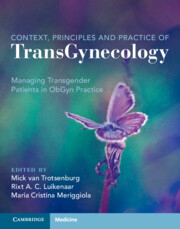Book contents
- Context, Principles, and Practice of Transgynecology
- Context, Principles, and Practice of Transgynecology
- Copyright page
- Dedication
- Contents
- Foreword
- Preface
- Contributors
- Abbreviations
- Section A Contextual Transgynecology
- Section B Practicing Transgynecology
- Section C Gynecological Surgery for Transgender Males
- Section D Sexuality and Contraception
- Section E Fertility and Reproduction
- Section F Impact of Gender-affirming Hormonal Therapy on Genital Organs
- Chapter 31 Changes to the Uterus from Supraphysiological Androgens
- Chapter 32 The Ovaries under Supraphysiological Androgen Exposure
- Chapter 33 The Vaginal and Neovaginal Microbiome under Androgen or Estrogen Exposure Respectively
- Section G Screening and Prophylaxis
- Transgynecology Index
- References
Chapter 31 - Changes to the Uterus from Supraphysiological Androgens
from Section F - Impact of Gender-affirming Hormonal Therapy on Genital Organs
Published online by Cambridge University Press: 22 December 2022
- Context, Principles, and Practice of Transgynecology
- Context, Principles, and Practice of Transgynecology
- Copyright page
- Dedication
- Contents
- Foreword
- Preface
- Contributors
- Abbreviations
- Section A Contextual Transgynecology
- Section B Practicing Transgynecology
- Section C Gynecological Surgery for Transgender Males
- Section D Sexuality and Contraception
- Section E Fertility and Reproduction
- Section F Impact of Gender-affirming Hormonal Therapy on Genital Organs
- Chapter 31 Changes to the Uterus from Supraphysiological Androgens
- Chapter 32 The Ovaries under Supraphysiological Androgen Exposure
- Chapter 33 The Vaginal and Neovaginal Microbiome under Androgen or Estrogen Exposure Respectively
- Section G Screening and Prophylaxis
- Transgynecology Index
- References
Summary
The uterus is known to undergo changes following exposure to supraphysiological doses of androgens, which are the doses typically used by trans masculine persons on gender-affirming hormone therapy. Clinically, most experience rapid onset amenorrhea but occasionally bleeding lasts up to 3–6 months. Uterine specimens derived from hysterectomy samples at the time of gender-affirming hysterectomy while on supraphysiological testosterone are found to be normal to small in size with thin endometrial linings that are predominately in the proliferative phase; the second most common endometrial histology is atrophy. There is also variation in the androgen receptor expressivity of the endometrium and myometrium following supraphysiological testosterone exposure. Pathology including fibroids, polyps, and adenomyosis continue to be seen, as well as endometrial hyperplasia and malignancy, though none are at increased frequency compared to cisgender females.
- Type
- Chapter
- Information
- Context, Principles and Practice of TransGynecologyManaging Transgender Patients in ObGyn Practice, pp. 233 - 235Publisher: Cambridge University PressPrint publication year: 2022



